氧化应激
氧化应激对细胞功能的影响及机制研究
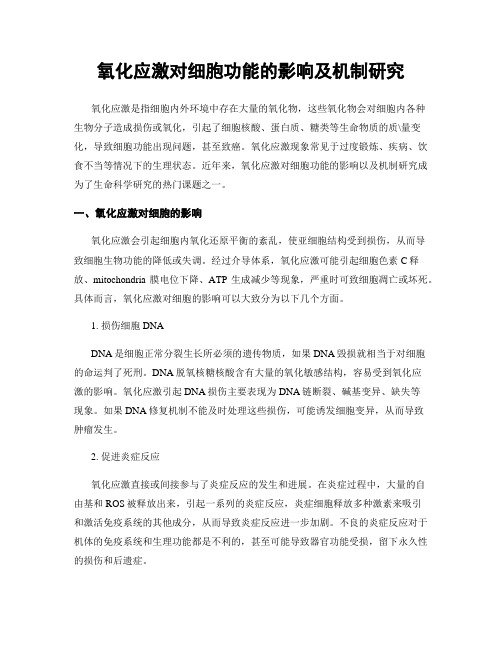
氧化应激对细胞功能的影响及机制研究氧化应激是指细胞内外环境中存在大量的氧化物,这些氧化物会对细胞内各种生物分子造成损伤或氧化,引起了细胞核酸、蛋白质、糖类等生命物质的质\量变化,导致细胞功能出现问题,甚至致癌。
氧化应激现象常见于过度锻炼、疾病、饮食不当等情况下的生理状态。
近年来,氧化应激对细胞功能的影响以及机制研究成为了生命科学研究的热门课题之一。
一、氧化应激对细胞的影响氧化应激会引起细胞内氧化还原平衡的紊乱,使亚细胞结构受到损伤,从而导致细胞生物功能的降低或失调。
经过介导体系,氧化应激可能引起细胞色素C释放、mitochondria膜电位下降、ATP生成减少等现象,严重时可致细胞凋亡或坏死。
具体而言,氧化应激对细胞的影响可以大致分为以下几个方面。
1. 损伤细胞DNADNA是细胞正常分裂生长所必须的遗传物质,如果DNA毁损就相当于对细胞的命运判了死刑。
DNA脱氧核糖核酸含有大量的氧化敏感结构,容易受到氧化应激的影响。
氧化应激引起DNA损伤主要表现为DNA链断裂、碱基变异、缺失等现象。
如果DNA修复机制不能及时处理这些损伤,可能诱发细胞变异,从而导致肿瘤发生。
2. 促进炎症反应氧化应激直接或间接参与了炎症反应的发生和进展。
在炎症过程中,大量的自由基和ROS被释放出来,引起一系列的炎症反应,炎症细胞释放多种激素来吸引和激活免疫系统的其他成分,从而导致炎症反应进一步加剧。
不良的炎症反应对于机体的免疫系统和生理功能都是不利的,甚至可能导致器官功能受损,留下永久性的损伤和后遗症。
3. 促进氧化性磷酸化氧化应激引起细胞内自由基浓度的增加,从而导致蛋白质、脂质分子等的氧化损伤。
氧化性蛋白质被检测到后磷酸化,进而经过一系列的途径形成氧化性磷酸化蛋白,而氧化性磷酸化蛋白则是促进了细胞死亡的重要因素,从而影响细胞的功能。
二、氧化应激的机制研究氧化应激在细胞中的反应机制主要分为两类,一类是由直接氧化应激产生的荧光染料(如二硫苏糖或者二氟苏糖)触发的信号通路,另一类是由间接氧化应激产生的荧光染料触发的信号通路。
氧化应激与葡萄糖,乳酸的关系
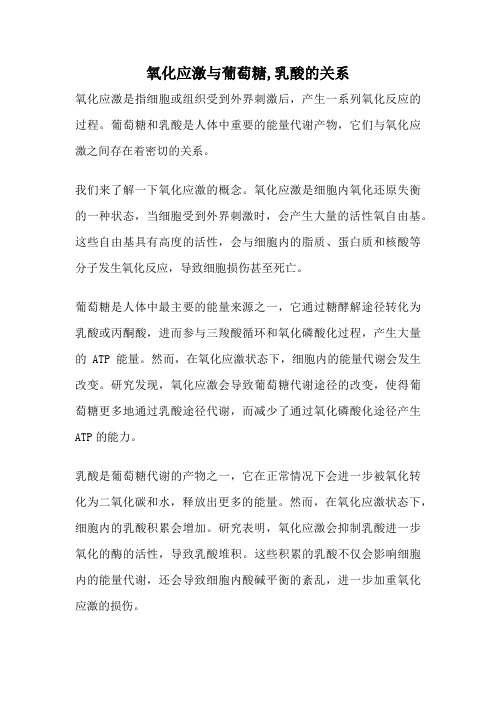
氧化应激与葡萄糖,乳酸的关系氧化应激是指细胞或组织受到外界刺激后,产生一系列氧化反应的过程。
葡萄糖和乳酸是人体中重要的能量代谢产物,它们与氧化应激之间存在着密切的关系。
我们来了解一下氧化应激的概念。
氧化应激是细胞内氧化还原失衡的一种状态,当细胞受到外界刺激时,会产生大量的活性氧自由基。
这些自由基具有高度的活性,会与细胞内的脂质、蛋白质和核酸等分子发生氧化反应,导致细胞损伤甚至死亡。
葡萄糖是人体中最主要的能量来源之一,它通过糖酵解途径转化为乳酸或丙酮酸,进而参与三羧酸循环和氧化磷酸化过程,产生大量的ATP能量。
然而,在氧化应激状态下,细胞内的能量代谢会发生改变。
研究发现,氧化应激会导致葡萄糖代谢途径的改变,使得葡萄糖更多地通过乳酸途径代谢,而减少了通过氧化磷酸化途径产生ATP的能力。
乳酸是葡萄糖代谢的产物之一,它在正常情况下会进一步被氧化转化为二氧化碳和水,释放出更多的能量。
然而,在氧化应激状态下,细胞内的乳酸积累会增加。
研究表明,氧化应激会抑制乳酸进一步氧化的酶的活性,导致乳酸堆积。
这些积累的乳酸不仅会影响细胞内的能量代谢,还会导致细胞内酸碱平衡的紊乱,进一步加重氧化应激的损伤。
葡萄糖和乳酸还参与细胞内的抗氧化防御系统。
葡萄糖作为细胞内的还原剂,可以提供电子,参与抗氧化酶如超氧化物歧化酶的活性,帮助清除自由基。
乳酸作为弱酸,可以与自由基结合,减少自由基对细胞的损伤。
因此,葡萄糖和乳酸在一定程度上可以缓解氧化应激对细胞的损伤。
氧化应激与葡萄糖、乳酸之间存在着密切的关系。
氧化应激状态下,细胞内的能量代谢发生改变,使得葡萄糖更多地通过乳酸途径代谢,而减少了通过氧化磷酸化途径产生ATP的能力。
同时,氧化应激还会导致乳酸堆积和细胞内酸碱平衡紊乱。
然而,葡萄糖和乳酸也参与细胞内的抗氧化防御系统,缓解氧化应激对细胞的损伤。
因此,研究葡萄糖和乳酸在氧化应激中的作用机制,对于理解氧化应激的发生和发展具有重要意义,也为预防和治疗相关疾病提供了新的思路。
氧化应激的评定方法
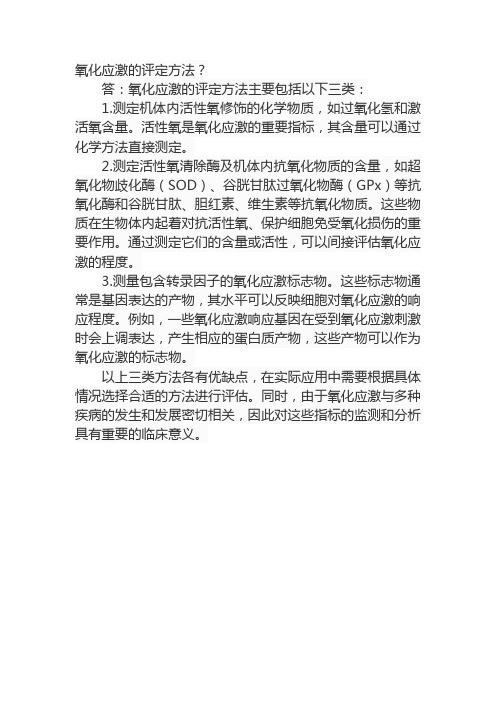
氧化应激的评定方法?
答:氧化应激的评定方法主要包括以下三类:
1.测定机体内活性氧修饰的化学物质,如过氧化氢和激活氧含量。
活性氧是氧化应激的重要指标,其含量可以通过化学方法直接测定。
2.测定活性氧清除酶及机体内抗氧化物质的含量,如超氧化物歧化酶(SOD)、谷胱甘肽过氧化物酶(GPx)等抗氧化酶和谷胱甘肽、胆红素、维生素等抗氧化物质。
这些物质在生物体内起着对抗活性氧、保护细胞免受氧化损伤的重要作用。
通过测定它们的含量或活性,可以间接评估氧化应激的程度。
3.测量包含转录因子的氧化应激标志物。
这些标志物通常是基因表达的产物,其水平可以反映细胞对氧化应激的响应程度。
例如,一些氧化应激响应基因在受到氧化应激刺激时会上调表达,产生相应的蛋白质产物,这些产物可以作为氧化应激的标志物。
以上三类方法各有优缺点,在实际应用中需要根据具体情况选择合适的方法进行评估。
同时,由于氧化应激与多种疾病的发生和发展密切相关,因此对这些指标的监测和分析具有重要的临床意义。
氧化应激中的h2o2

氧化应激中的h2o2
氧化应激是一种细胞应激反应,指的是细胞内氧化还原平衡被破坏,导致氧化物质积累,从而损害细胞结构和功能的现象。
H2O2是氧化应激中的重要分子,其在细胞内具有双重作用。
一方面,适量的H2O2可以通过调节细胞信号通路,促进细胞生长、增加免疫力和抗氧化能力等。
另一方面,过量的H2O2会破坏DNA、蛋白质和脂质等生物分子的结构和功能,导致细胞死亡和组织损伤。
因此,细胞需要维持H2O2的平衡,使其适量、适时、适地产生和清除。
细胞内有多个抗氧化酶和分子可以调节H2O2的水平,例如超氧化物歧化酶、谷胱甘肽过氧化物酶、半胱氨酸等。
氧化应激和H2O2在多种疾病中发挥着重要作用,例如心血管疾病、癌症、神经退行性疾病等。
因此,研究氧化应激和H2O2的调节机制,对于预防和治疗这些疾病具有重要意义。
- 1 -。
蛋白激酶c 氧化应激-概述说明以及解释
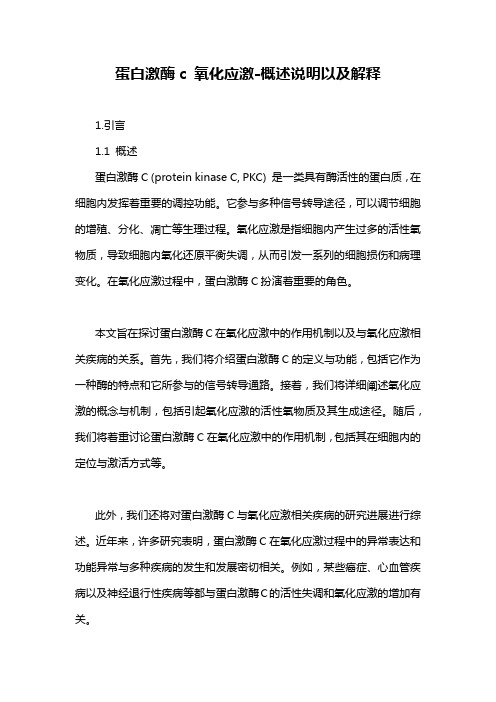
蛋白激酶c 氧化应激-概述说明以及解释1.引言1.1 概述蛋白激酶C (protein kinase C, PKC) 是一类具有酶活性的蛋白质,在细胞内发挥着重要的调控功能。
它参与多种信号转导途径,可以调节细胞的增殖、分化、凋亡等生理过程。
氧化应激是指细胞内产生过多的活性氧物质,导致细胞内氧化还原平衡失调,从而引发一系列的细胞损伤和病理变化。
在氧化应激过程中,蛋白激酶C扮演着重要的角色。
本文旨在探讨蛋白激酶C在氧化应激中的作用机制以及与氧化应激相关疾病的关系。
首先,我们将介绍蛋白激酶C的定义与功能,包括它作为一种酶的特点和它所参与的信号转导通路。
接着,我们将详细阐述氧化应激的概念与机制,包括引起氧化应激的活性氧物质及其生成途径。
随后,我们将着重讨论蛋白激酶C在氧化应激中的作用机制,包括其在细胞内的定位与激活方式等。
此外,我们还将对蛋白激酶C与氧化应激相关疾病的研究进展进行综述。
近年来,许多研究表明,蛋白激酶C在氧化应激过程中的异常表达和功能异常与多种疾病的发生和发展密切相关。
例如,某些癌症、心血管疾病以及神经退行性疾病等都与蛋白激酶C的活性失调和氧化应激的增加有关。
最后,我们将总结蛋白激酶C在氧化应激中的作用和意义,并讨论当前研究存在的问题和展望。
通过对蛋白激酶C氧化应激的深入理解,我们有望为相关疾病的防治提供新的思路和策略。
综上所述,本文将全面探讨蛋白激酶C在氧化应激中的作用机制及其与相关疾病的关联,旨在深化对氧化应激生物学的认识,并为相关疾病的研究和治疗提供理论依据。
1.2 文章结构文章结构部分的内容可以包括以下内容:文章结构这一部分主要介绍了整篇文章的组织结构和各个章节的内容概述,读者可以通过这一部分对整个文章的框架有一个清晰的认识。
2.正文部分分为四个章节,分别是蛋白激酶c的定义与功能、氧化应激的概念与机制、蛋白激酶c在氧化应激中的作用以及蛋白激酶c与氧化应激相关疾病的研究进展。
2.1 蛋白激酶c的定义与功能部分将介绍蛋白激酶c的基本定义和功能,包括其结构、酶活性以及在细胞信号转导中的作用。
氧化应激检测指标

氧化应激检测指标
氧化应激是指生物体内氧化还原平衡被破坏,导致氧自由基和其他反应性氧物种的过度产生,从而引起细胞和组织的损伤。
氧化应激与多种疾病的发生和发展密切相关,如心血管疾病、神经系统疾病、炎症性疾病、肿瘤等。
因此,氧化应激的检测对于早期发现疾病、指导治疗和预防疾病的发生具有重要意义。
目前,氧化应激的检测指标包括以下几个方面:
1、氧自由基的产生和清除能力。
氧自由基是氧化应激的主要产物,氧自由基的过度产生将引起细胞的氧化损伤。
因此,检测氧自由基的产生和清除能力,可以评估氧化应激水平的高低。
2、抗氧化能力。
抗氧化能力是指生物体对氧自由基和其他反应性氧物种的清除能力。
抗氧化能力的降低会导致氧化应激的加重,从而引起疾病的发生和发展。
3、氧化脂质水平。
脂质过氧化是氧化应激的主要表现之一。
检测氧化脂质水平,可以客观评估氧化应激的程度。
4、氧化DNA水平。
氧化DNA水平的升高,会导致DNA的损伤和突变,从而引起肿瘤等疾病的发生。
综上所述,氧化应激的检测指标多种多样,可以从不同角度客观评估氧化应激的程度,为疾病的早期发现和预防提供有力的支持。
- 1 -。
氧化应激与身体健康的关系分析

氧化应激与身体健康的关系分析氧化应激是指由于体内氧化反应引起的细胞损伤和炎症反应,是许多疾病的共同基础,包括心血管疾病、癌症、糖尿病、中风、阿尔茨海默病等。
在生物学中,氧气是维持生命的必需品,但它在代谢过程中,可产生自由基,导致氧化应激。
自由基是一种具有高度活性的分子,它们会对细胞膜、核酸、蛋白质和多种代谢物质造成损伤。
这些自由基会产生许多不良反应,如细胞死亡、癌症、动脉粥样硬化等,所以氧化应激是一个极其重要的生物学问题。
1. 氧化应激与健康氧化应激是一种病理过程,它会影响人体的各个方面。
氧化应激会产生许多不良反应,如DNA的损伤和突变、蛋白质的氧化、细胞膜的破坏等,从而影响细胞的生命活动。
氧化应激还可对健康产生负面影响,如增加心血管疾病、中风、糖尿病和肥胖症的风险。
此外,氧化应激会加速细胞衰老和老化,是许多退化性疾病的共同因素。
2. 如何预防氧化应激氧化应激是一种普遍存在的自然现象,但我们可以通过以下方法预防氧化应激:1)控制饮食:多吃富含抗氧化剂的食物,如豆类、果蔬、坚果、鱼类等。
2)保持运动:定期进行适量的有氧运动,提高身体的氧化能力。
3)降低压力:过度的压力会导致大量的氧化反应,增加身体内氧化应激。
4)维生素C和E:它们对身体内的自由基有很好的抑制作用。
3. 氧化应激与肌肉损伤的关系肌肉损伤是一种常见的损伤类型,如在运动中肌肉的受伤会导致肌肉的疼痛和不适。
这种损伤还会导致氧化应激的产生。
在肌肉损伤后,好的自由基会加强细胞的修复和增生,而坏的自由基会导致细胞衰老和死亡。
氧化应激的形成不仅会对肌肉的康复产生影响,还可能对身体其他方面造成负面影响,如心血管系统和免疫系统。
4. 研究趋势氧化应激是一个重要的生物学问题,目前有关氧化应激的研究一直是科学家们的热点和难点。
为了研究其机制,寻找有效的治疗方法,许多科学家和医生都加入了氧化应激研究的行列。
目前的研究方向包括:研究氧化应激的分子机制、开发新的抗氧化剂和抗氧化治疗、研究氧化应激与疾病之间的关系等。
氧化应激和氨甲酰化-概述说明以及解释

氧化应激和氨甲酰化-概述说明以及解释1.引言1.1 概述概述氧化应激和氨甲酰化是生物体内常见的两种重要生物化学过程。
氧化应激是指细胞内外环境中活性氧种和活性氮种的增加,导致细胞内氧化还原平衡失调,从而引发一系列的生理和病理反应。
而氨甲酰化则是一种特定的化学反应,即将氨基和甲酰基结合在一起形成甲酰胺。
这两个过程在细胞内的真核和原核生物中广泛存在,并在许多重要的生物过程发挥着关键的作用。
在氧化应激中,活性氧种和活性氮种作为重要的信号分子,参与了细胞信号传导、基因表达调控、蛋白质翻译和修饰等多个生物过程。
然而,当氧化应激过程受到外界或内源性因素的干扰,如环境污染、炎症反应、疾病状态等,会使活性氧种和活性氮种的产生和清除失衡,进而导致细胞发生一系列的氧化应激损伤。
这些损伤包括细胞膜的损伤、DNA和蛋白质的氧化,以及细胞内平衡的紊乱等。
与氧化应激不同,氨甲酰化是一种特定的代谢反应,在生物体内发挥着重要的生理功能。
氨甲酰化反应是针对氨基和甲酰基之间的结合,通过氨酸代谢途径中的酶促反应完成。
在生物体内,氨甲酰化反应参与了多个重要的生理过程,包括蛋白质合成、能量代谢、基因表达调控等。
此外,氨甲酰化还与一些疾病发生发展密切相关,如肿瘤、代谢性疾病、神经系统疾病等。
本文将重点讨论氧化应激和氨甲酰化两个生物过程的概念、机制、影响因素以及在生物体中的生理和病理作用。
通过对这两个过程的深入了解,可以更好地认识它们在细胞内的作用机制,为相关疾病的防治提供理论依据。
最后,本文还将展望未来对氧化应激和氨甲酰化的研究方向,以期为进一步揭示这两个生物过程的功能和调控提供新的思路和研究方法。
1.2 文章结构文章结构是指文章整体的组织和布局,主要包括引言、正文和结论三个部分。
具体到本篇文章的结构,可以分为以下几个部分:1. 引言引言部分主要对氧化应激和氨甲酰化进行概述,介绍其背景和重要性。
在概述中可以提到氧化应激和氨甲酰化的概念、研究现状以及相关领域中的应用和意义。
氧化应激

• 硫氧还原蛋白(TRX) • TRX为细胞内重要的氧化还原调节分子之一;遇有病
毒感染、紫外线和环境污染物等各种刺激时,将诱导其细 胞内表达。 即使TRX单独存在也可表现出对单态氧和羟自 由基的消除作用,除可作为抗氧化剂使用之外,还用做还 原蛋白的二硫键。进一步,就突触传递, TRX能够抑制 ASK1和p38MAPK的活化。再者,认识到TRX也同样向细胞 外释放,显示其细胞因子/趋化因子样作用。有报告指出, 在与人类疾病的相互关系方面,HIV感染者和丙型肝炎患 者的血清中,可出现TRX浓度的上升。此外尚注意到,对 包括风湿性关节炎在内的自身免疫性疾病、缺血再灌注损 伤以及慢性心功能不全之类可导致氧化应激的疾病,亦均 可应用TRX做有效评价。TRX已有检测试剂盒。
氧化应激的产生
• 氧化应激的产生既有内部也有外部的。外因包括接触环境
• •
污染、石化制品或重金属;内因包括慢性或急性感染,还 有血糖调节方面存在的问题。 氧化应激的出现还与生活方式有关,如吸烟、喝酒、 运动过度、服用药物,还有进食过量。特别要注意的是, 日晒(紫外线辐射)过多也会引起氧化应激。 此外,营养物质的缺乏也会导致氧化应激。如果我们 缺硒,或者体内的维生素E、维生素A或其他关键性抗氧化 剂含量不足,那么就无法给自身提供维护抗氧化系统正常 工作的必要因素。体重超重也有危害,脂肪组织制造发炎 分子,从而导致氧化应激。
•
•
•
大部分与老化有关的健康问题,如皱纹、心脏 病和阿尔兹海默症,都与体内氧化应激过大有关。 正如美国加州大学伯克利分校的邓汉姆· 哈尔蒙博 士指出的那样:“很少有人能活到他们潜在的最 大寿命。他们往往提早死于各种疾病,其中很大 一部分是自由基引发的。”尽管哈尔蒙博士的研 究成果已经是半个世纪以前的事了,人们却直到 最近才对他的理念有所了解。 事实上,人体几乎所有的器官都很容易受到氧 化应激带来的伤害,症状表现不计其数,如疲倦、 全身无力、肌肉和关节痛、消化不良、焦虑、抑 郁、皮肤瘙痒、头痛,以及注意力难以集中和感 染难以痊愈等。由氧化应激水平升高诱发的最常 见疾病有心脏病、癌症、骨关节炎、风湿性关节 炎、糖尿病以及神经退化性问题如阿尔兹海默症、 帕金森病。
氧化应激与抗氧化剂的作用机制
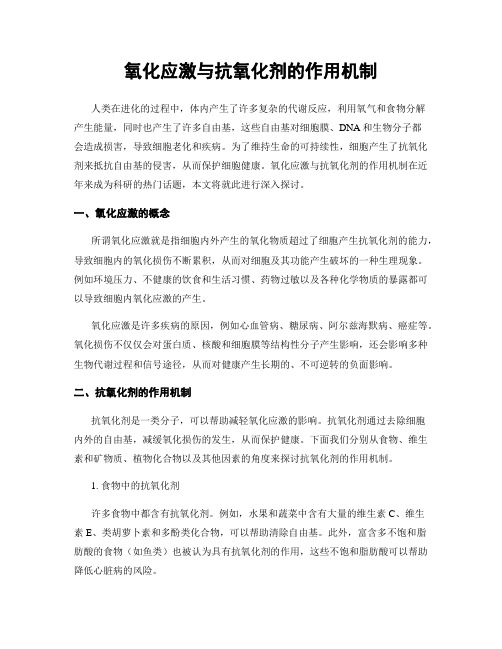
氧化应激与抗氧化剂的作用机制人类在进化的过程中,体内产生了许多复杂的代谢反应,利用氧气和食物分解产生能量,同时也产生了许多自由基,这些自由基对细胞膜、DNA和生物分子都会造成损害,导致细胞老化和疾病。
为了维持生命的可持续性,细胞产生了抗氧化剂来抵抗自由基的侵害,从而保护细胞健康。
氧化应激与抗氧化剂的作用机制在近年来成为科研的热门话题,本文将就此进行深入探讨。
一、氧化应激的概念所谓氧化应激就是指细胞内外产生的氧化物质超过了细胞产生抗氧化剂的能力,导致细胞内的氧化损伤不断累积,从而对细胞及其功能产生破坏的一种生理现象。
例如环境压力、不健康的饮食和生活习惯、药物过敏以及各种化学物质的暴露都可以导致细胞内氧化应激的产生。
氧化应激是许多疾病的原因,例如心血管病、糖尿病、阿尔兹海默病、癌症等。
氧化损伤不仅仅会对蛋白质、核酸和细胞膜等结构性分子产生影响,还会影响多种生物代谢过程和信号途径,从而对健康产生长期的、不可逆转的负面影响。
二、抗氧化剂的作用机制抗氧化剂是一类分子,可以帮助减轻氧化应激的影响。
抗氧化剂通过去除细胞内外的自由基,减缓氧化损伤的发生,从而保护健康。
下面我们分别从食物、维生素和矿物质、植物化合物以及其他因素的角度来探讨抗氧化剂的作用机制。
1. 食物中的抗氧化剂许多食物中都含有抗氧化剂。
例如,水果和蔬菜中含有大量的维生素C、维生素E、类胡萝卜素和多酚类化合物,可以帮助清除自由基。
此外,富含多不饱和脂肪酸的食物(如鱼类)也被认为具有抗氧化剂的作用,这些不饱和脂肪酸可以帮助降低心脏病的风险。
2. 维生素和矿物质许多维生素和矿物质也被认为具有抗氧化剂的作用。
例如,维生素C和维生素E可以帮助清除细胞内的自由基,从而保护健康。
此外,矿物质如锌、硒、铜等也被发现与氧化应激的发生和身体健康联系紧密。
3. 植物化合物植物化合物被认为是最强的抗氧化剂之一。
许多草药、茶叶和植物提取物中都含有大量的抗氧化化合物。
例如,多酚类化合物和黄酮类化合物都被证明可以减轻氧化应激,从而保护健康。
氧化应激与缺氧的关系
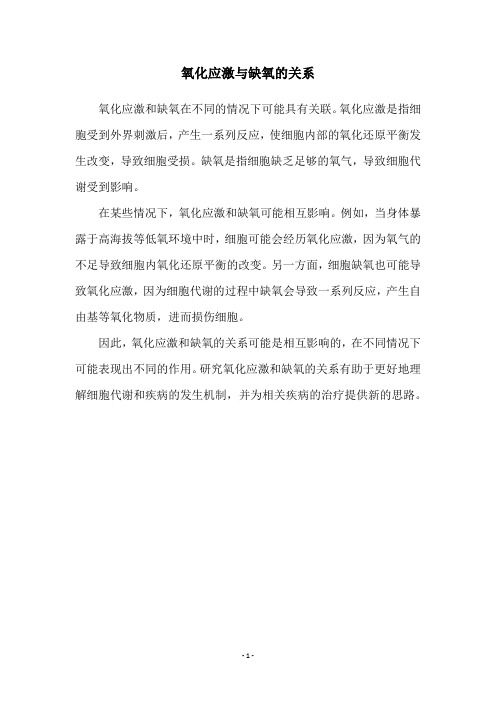
氧化应激与缺氧的关系
氧化应激和缺氧在不同的情况下可能具有关联。
氧化应激是指细胞受到外界刺激后,产生一系列反应,使细胞内部的氧化还原平衡发生改变,导致细胞受损。
缺氧是指细胞缺乏足够的氧气,导致细胞代谢受到影响。
在某些情况下,氧化应激和缺氧可能相互影响。
例如,当身体暴露于高海拔等低氧环境中时,细胞可能会经历氧化应激,因为氧气的不足导致细胞内氧化还原平衡的改变。
另一方面,细胞缺氧也可能导致氧化应激,因为细胞代谢的过程中缺氧会导致一系列反应,产生自由基等氧化物质,进而损伤细胞。
因此,氧化应激和缺氧的关系可能是相互影响的,在不同情况下可能表现出不同的作用。
研究氧化应激和缺氧的关系有助于更好地理解细胞代谢和疾病的发生机制,并为相关疾病的治疗提供新的思路。
- 1 -。
氧化应激

• 硫氧还原蛋白(TRX) 硫氧还原蛋白(TRX) • TRX为细胞内重要的氧化还原调节分子之一;遇有病 TRX染、紫外线和环境污染物等各种刺激时,将诱导其细 胞内表达。 即使TRX单独存在也可表现出对单态氧和羟自 即使TRX单独存在也可表现出对单态氧和羟自 由基的消除作用,除可作为抗氧化剂使用之外,还用做还 原蛋白的二硫键。进一步,就突触传递, TRX能够抑制 TRX能够抑制 ASK1和p38MAPK的活化。再者,认识到TRX也同样向细胞 ASK1和p38MAPK的活化。再者,认识到TRX也同样向细胞 外释放,显示其细胞因子/趋化因子样作用。有报告指出, 外释放,显示其细胞因子/趋化因子样作用。有报告指出, 在与人类疾病的相互关系方面,HIV感染者和丙型肝炎患 在与人类疾病的相互关系方面,HIV感染者和丙型肝炎患 者的血清中,可出现TRX浓度的上升。此外尚注意到,对 者的血清中,可出现TRX浓度的上升。此外尚注意到,对 包括风湿性关节炎在内的自身免疫性疾病、缺血再灌注损 包括风湿性关节炎在内的自身免疫性疾病、缺血再灌注损 伤以及慢性心功能不全之类可导致氧化应激的疾病,亦均 伤以及慢性心功能不全之类可导致氧化应激的疾病,亦均 可应用TRX做有效评价。TRX已有检测试剂盒。 可应用TRX做有效评价。TRX已有检测试剂盒。
简介 •
• 氧化应激的概念最早源于人类对衰老的认识。1956年英国学者 氧化应激的概念最早源于人类对衰老的认识。1956年英国学者
Harmna首次提出自由基衰老学说 该学说认为自由基 Harmna首次提出自由基衰老学说,该学说认为自由基(Free radical) 首次提出自由基衰老学说, 自由基(Free 攻击生命大分子造成组织细胞损伤,是引起机体衰老的根本原因, 攻击生命大分子造成组织细胞损伤,是引起机体衰老的根本原因,也是 诱发肿瘤等恶性疾病的重要起因。1990年美国衰老研究权威 诱发肿瘤等恶性疾病的重要起因。1990年美国衰老研究权威Sohal 肿瘤等恶性疾病的重要起因 衰老研究权威Sohal 教授指出了自由基衰老学说的种种缺陷, 教授指出了自由基衰老学说的种种缺陷,并首先提出了氧化应激的概 念。 • 氧化应激是指机体在遭受各种有害刺激时, 氧化应激是指机体在遭受各种有害刺激时,体内高活性分子如活 性氧自由基(reactive species,ROS)和活性氮自由基 性氧自由基(reactive oxygen species,ROS)和活性氮自由基 (reactive nitrogen species,RNS)产生过多,氧化程度超出氧化物的 species,RNS)产生过多 产生过多, 清除,氧化系统和抗氧化系统失衡,从而导致组织损伤。 清除,氧化系统和抗氧化系统失衡,从而导致组织损伤。 • ROS包括超氧阴离子 ROS包括超氧阴离子(.O₂-)、羟自由基(.OH)和过氧化氢(H₂O₂) 包括超氧阴离子(.O₂ 羟自由基(.OH)和过氧化氢 ₂ 和过氧化氢(H ;RNS包括一氧化氮 包括一氧化氮(.NO)、二氧化氮(.NO₂ 等;RNS包括一氧化氮(.NO)、二氧化氮(.NO₂)和过氧化亚硝酸盐 (.ONOO(.ONOO-)等。机体存在两类抗氧化系统,一类是酶抗氧化系统,包括 机体存在两类抗氧化系统,一类是酶抗氧化系统, 超氧化物歧化酶(SOD)、过氧化氢酶(CAT)、 超氧化物歧化酶(SOD)、过氧化氢酶(CAT)、谷胱甘肽过氧化物酶 (GSH-Px)等 另一类是非酶抗氧化系统,包括维生素C 维生素E (GSH-Px)等;另一类是非酶抗氧化系统,包括维生素C、维生素E、谷 胱甘肽、褪黑素、α-硫辛酸、类胡萝卜素、微量元素铜、锌、硒(Se) 胱甘肽、褪黑素、 硫辛酸、类胡萝卜素、微量元素铜、 等。
氧化应激反应是否是机体组织细胞低氧损伤的罪魁祸首
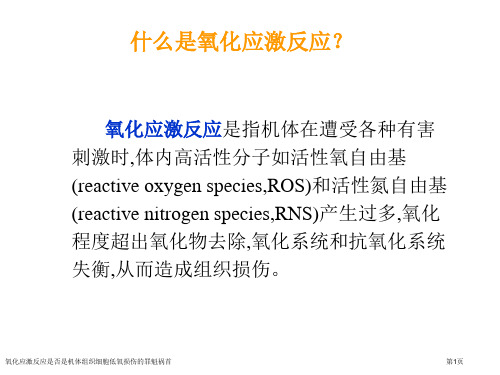
氧化应激反应是否是机体组织细胞低氧损伤的罪魁祸首
第1页
ROS包含超氧阴离子(.O2-)、羟自由基(.OH) 和过氧化氢(H2O2)等;
RNS包含一氧化氮(.NO)、二氧化氮(.NO2)和 过氧化亚硝酸盐(.ONOO-)等。
氧化应激反应是否是机体组织细胞低氧损伤的罪魁祸首
第2页
机体存在两类抗氧化系统
第4页
氧化应激反应是否是机体组织细胞低氧损伤的罪魁祸首
第5页
氧化应激生理反应过程
低氧
HIF-1α
SOD
×
CAT
×
ROS
H2O2
H2O+O2
细胞色素C氧化酶活性↓
组织细胞损伤
氧化应激反应是否是机体组织细胞低氧损伤的罪魁祸首
第6页
HIF-1α↑ 氧代谢增加
细胞色素C氧化酶↓↓ ROS↑↑
低氧预测
H20 ROS↓
0.601±0.039 2.008 0.029
脑 0.5072±0.019
0.301±0.034 1.998 0.043
氧化应激反应是否是机体组织细胞低氧损伤的罪魁祸首
第17页
实际所测结果
HIF-1α↑ 氧代谢降低
细胞色素C氧化酶↓ ROS↓↓
低氧
H20 ROS↓
SOD,CAT↓
SOD,CAT↓
氧化应激反应是否是机体组织细胞低氧损伤的罪魁祸首
什么是氧化应激反应?
氧化应激反应是指机体在遭受各种有害 刺激时,体内高活性分子如活性氧自由基 (reactive oxygen species,ROS)和活性氮自由基 (reactive nitrogen species,RNS)产生过多,氧化 程度超出氧化物去除,氧化系统和抗氧化系统 失衡,从而造成组织损伤。
氧化应激机制
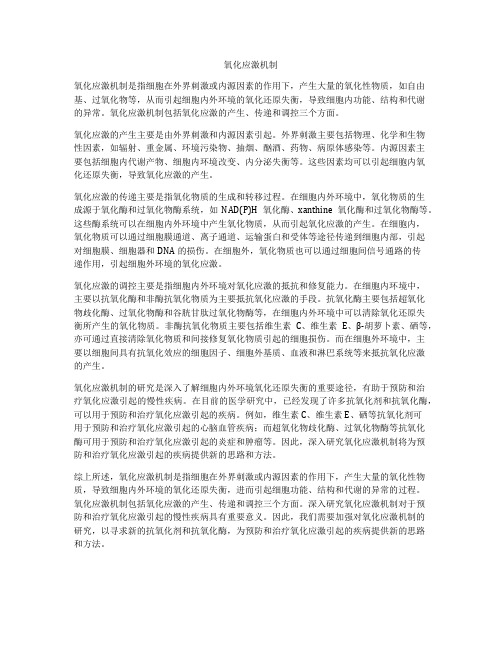
氧化应激机制氧化应激机制是指细胞在外界刺激或内源因素的作用下,产生大量的氧化性物质,如自由基、过氧化物等,从而引起细胞内外环境的氧化还原失衡,导致细胞内功能、结构和代谢的异常。
氧化应激机制包括氧化应激的产生、传递和调控三个方面。
氧化应激的产生主要是由外界刺激和内源因素引起。
外界刺激主要包括物理、化学和生物性因素,如辐射、重金属、环境污染物、抽烟、酗酒、药物、病原体感染等。
内源因素主要包括细胞内代谢产物、细胞内环境改变、内分泌失衡等。
这些因素均可以引起细胞内氧化还原失衡,导致氧化应激的产生。
氧化应激的传递主要是指氧化物质的生成和转移过程。
在细胞内外环境中,氧化物质的生成源于氧化酶和过氧化物酶系统,如NAD(P)H氧化酶、xanthine氧化酶和过氧化物酶等。
这些酶系统可以在细胞内外环境中产生氧化物质,从而引起氧化应激的产生。
在细胞内,氧化物质可以通过细胞膜通道、离子通道、运输蛋白和受体等途径传递到细胞内部,引起对细胞膜、细胞器和DNA的损伤。
在细胞外,氧化物质也可以通过细胞间信号通路的传递作用,引起细胞外环境的氧化应激。
氧化应激的调控主要是指细胞内外环境对氧化应激的抵抗和修复能力。
在细胞内环境中,主要以抗氧化酶和非酶抗氧化物质为主要抵抗氧化应激的手段。
抗氧化酶主要包括超氧化物歧化酶、过氧化物酶和谷胱甘肽过氧化物酶等,在细胞内外环境中可以清除氧化还原失衡所产生的氧化物质。
非酶抗氧化物质主要包括维生素C、维生素E、β-胡萝卜素、硒等,亦可通过直接清除氧化物质和间接修复氧化物质引起的细胞损伤。
而在细胞外环境中,主要以细胞间具有抗氧化效应的细胞因子、细胞外基质、血液和淋巴系统等来抵抗氧化应激的产生。
氧化应激机制的研究是深入了解细胞内外环境氧化还原失衡的重要途径,有助于预防和治疗氧化应激引起的慢性疾病。
在目前的医学研究中,已经发现了许多抗氧化剂和抗氧化酶,可以用于预防和治疗氧化应激引起的疾病。
例如,维生素C、维生素E、硒等抗氧化剂可用于预防和治疗氧化应激引起的心脑血管疾病;而超氧化物歧化酶、过氧化物酶等抗氧化酶可用于预防和治疗氧化应激引起的炎症和肿瘤等。
氧化应激产生的原因

氧化应激产生的原因
氧化应激是一种常见的生理现象,是因为体内的氧自由基(ROS)数量过多所引起的。
ROS是机体内生成的一种高反应性的氧化物质,它们在生物体内有着许多不同的代谢作用,但是当数量过多时,ROS就会产生氧化应激的现象。
氧化应激的产生是由多方面因素共同作用的结果:
1. 环境污染
环境污染是导致ROS产生的重要原因之一。
大气中的工业废气、汽车尾气等都含有大量的有害物质,这些物质能够刺激机体产生ROS。
长期暴露在环境污染中,会造成机体内的ROS过多从而产生氧化应激。
2. 不正常的代谢
机体正常的代谢也会产生ROS,这是因为在代谢过程中氧气能够接受电子从而形成ROS。
如果机体代谢出现问题,如饮食失调,能量代谢紊乱等,就会产生过多的ROS从而发生氧化应激。
3. 强烈的运动
运动可以增强身体的健康,但是过于强烈的运动也会导致氧化应激的现象。
在高强度运动中,机体需要更多的氧气以支持肌肉的工作,从而产生更多的ROS。
如果运动强度过大而时间不充足,ROS就会开始积累,导致氧化应激的出现。
4. 营养不良
营养不良会导致机体缺乏抗氧化物质,从而不能有效地清除ROS,导致ROS的堆积。
长期以往,容易导致氧化应激的发生。
此外,过多的糖分等也会加速ROS的产生。
氧化应激是一种较为普遍的现象,虽然在正常情况下可以被机体有效消除和调节,但是如果出现过多的ROS产生,就会导致发病或者加速衰老等一系列不良反应。
控制好生活中各种因素有助于减缓机体的氧化应激反应。
氧化应激与抗氧化防御的分子机制

氧化应激与抗氧化防御的分子机制人体内的生命活动是通过化学反应来完成的。
而化学反应存在一定的风险,就像火柴摩擦产生的火苗一样,有可能引起氧化应激反应,这种反应会破坏细胞结构和分子功能。
为了保护我们的身体不受氧化应激反应的侵害,我们需要抗氧化防御机制。
一、氧化应激的原理氧化应激是指因为机体暴露在氧气中而产生的毒性反应,产生这种反应的主要原因是氧(O₂)和其他分子之间发生的化学反应。
比如当细胞内的自由基过多时,就会引发氧化反应。
自由基是一种非常活跃的分子,它们会从已有分子中夺取电子,使得原本稳定的分子变得不稳定。
氧化应激反应所造成的损伤一般表现为细胞膜的破裂、DNA链的断裂、蛋白质的降解等,这些都会影响人体的健康和免疫系统。
同时,氧化应激还会引起多种疾病,比如白内障、动脉硬化和阿尔兹海默症等。
二、抗氧化防御机制的原理为了应对氧化应激的发生,人体内存在一套完善的抗氧化防御系统。
这个系统由多种分子组成,比如维生素C、维生素E和谷胱甘肽等。
这些分子通过各种机制消除自由基,以保护人体免受氧化应激的伤害。
抗氧化防御机制的本质是消除自由基。
消除自由基的方法很多,其中最常见的是与自由基结合的抗氧化剂。
抗氧化剂的作用是捕捉自由基中的单个电子,把它们变成稳定的结构。
由于抗氧化剂也会失去他们自己的电子,所以它们本身也需要零散的被再生。
还有一些其他的消除自由基的方法,比如维生素E通过给氧化自由基提供电子来去除它们,胡萝卜素则通过吸收紫外线来保护皮肤免受紫外线辐射的损害。
三、氧化应激和抗氧化防御的平衡牢固的健康的抗氧化防御机制非常重要,但是人体内抗氧化防御系统的自我维持和保护虽然有能力一定程度上控制自由基的生成,但并不能完全消除,因此保持适度的氧化应激状态也是非常重要的。
如果抗氧化防御机制不能够经常、稳步地工作,那么氧化应激就会存在大量未被抑制的情况下发生在人体内,也就是所谓的氧化应激反应过剩。
如果氧化应激过度,身体会出现一系列的反应,比如白内障、动脉硬化和阿尔兹海默症等。
- 1、下载文档前请自行甄别文档内容的完整性,平台不提供额外的编辑、内容补充、找答案等附加服务。
- 2、"仅部分预览"的文档,不可在线预览部分如存在完整性等问题,可反馈申请退款(可完整预览的文档不适用该条件!)。
- 3、如文档侵犯您的权益,请联系客服反馈,我们会尽快为您处理(人工客服工作时间:9:00-18:30)。
氧化应激
本综述由解螺旋学员穿山甲说了什么负责整理(2017年12月)
氧化应激(oxidative stress, OS)是指体内氧化与抗氧化作用失衡,倾向于氧化而导致的组织损伤。
1, 2一旦发生氧化应激,许多细胞生物分子,如DNA、脂质和蛋白质就会容易受到自由基引起的氧化损伤,从而导致细胞和最终的组织器官功能障碍。
氧化应激与多种疾病有关。
1.心血管疾病
过多的氧化应激反应物的堆积对血管系统有害1,它们会损伤内皮和平滑肌细胞膜,减少NO水平,氧化四氢生物蝶呤(BH4)作为一氧化氮合酶(NOS)的辅助因子,促进不对称二甲基精氨酸(ADMA)的合成,产生NOS抑制物,抑制鸟苷环化酶。
其中的一个机制是低密度脂蛋白(LDL)中的多不饱和脂肪酸氧化成氧化低密度脂蛋白(oxLDL),这也是动脉粥样硬化的一个中间产物。
3-5ROS依赖的信号通路引起转录和表观遗传失调,导致慢性低度炎症、血小板活化和内皮功能障碍。
4, 6心血管疾病与心肌细胞活性氧族(ROS)的过多有关。
7, 8
2.神经退行性疾病9-11
图1. 氧化应激与各种神经退行性疾病的关系
3.系统性红斑狼疮(SLE)
SLE的特点是产生有害的自身抗原,炎症因子的过度作用,以及破坏性的组织和器官损
伤。
所有这些紊乱都会因活性氧的异常消耗和过量生成而增强或减弱。
12氧化应激在SLE中增加,导致免疫系统失调、细胞死亡信号的异常激活和处理、自身抗体的产生和致死性并发症。
自身抗原的氧化修饰引起自身免疫,血清蛋白的氧化修饰程度与SLE的疾病活动和器官损害密切相关。
13
4.慢性阻塞性肺疾病(COPD)
有证据表明COPD患者存在氧化和羰基应激,特别是在急性加重期。
14COPD患者的肺泡巨噬细胞更活跃,释放更多的活性氧,表现为超氧自由基和过氧化氢。
15COPD患者激活的外周血中性粒细胞释放的活性氧增加,特别是在病情恶化期间。
14COPD常加重期患者体内内源性抗氧化物谷胱甘肽的浓度低于稳定期患者。
16
5.高血压病
ROS影响高血压发展的过程包括氧化还原敏感信号通路的激活,尤其是在血管系统中,血管扩张剂NO减少,ROS生成增加。
17, 18
OS与多种疾病有关,但研究最多的还是心血管疾病。
针对OS与各疾病的关系,已经出现了抗OS的治疗方案。
参考文献
1. Annuk M, Zilmer M, Fellstrom B. Endothelium-dependent vasodilation and oxidative stress in chronic renal failure: impact on cardiovascular disease. Kidney Int Suppl 2003; (84): S50-3.
2. Al Shahrani M, Heales S, Hargreaves I, Orford M. Oxidative Stress: Mechanistic Insights into Inherited Mitochondrial Disorders and Parkinson's Disease. J Clin Med 2017; 6(11).
3. Heinecke JW. Oxidants and antioxidants in the pathogenesis of atherosclerosis: implications for the oxidized low density lipoprotein hypothesis. Atherosclerosis 1998; 141(1): 1-15.
4. Santilli F, D'Ardes D, Davi G. Oxidative stress in chronic vascular disease: From prediction to prevention. Vascul Pharmacol 2015; 74: 23-37.
5. He F, Zuo L. Redox Roles of Reactive Oxygen Species in Cardiovascular Diseases. Int J Mol Sci 2015; 16(11): 27770-80.
6. Santilli F, Guagnano M, Vazzana N, La Barba S, Davi G. Oxidative stress drivers
and modulators in obesity and cardiovascular disease: from biomarkers to therapeutic approach. Curr Med Chem 2015; 22(5): 582-95.
7. Kim HK, Han J. Mitochondria-Targeted Antioxidants for the Treatment of Cardiovascular Disorders. Adv Exp Med Biol 2017; 982: 621-46.
8. Cervantes Gracia K, Llanas-Cornejo D, Husi H. CVD and Oxidative Stress. J Clin Med 2017; 6(2).
9. Liu Z, Zhou T, Ziegler AC, Dimitrion P, Zuo L. Oxidative Stress in Neurodegenerative Diseases: From Molecular Mechanisms to Clinical Applications. Oxid Med Cell Longev 2017; 2017: 2525967.
10. Islam MT. Oxidative stress and mitochondrial dysfunction-linked neurodegenerative disorders. Neurol Res 2017; 39(1): 73-82.
11. Guo C, Sun L, Chen X, Zhang D. Oxidative stress, mitochondrial damage and neurodegenerative diseases. Neural Regen Res 2013; 8(21): 2003-14.
12. Lee HT, Wu TH, Lin CS, et al. The pathogenesis of systemic lupus erythematosus - From the viewpoint of oxidative stress and mitochondrial dysfunction. Mitochondrion 2016; 30: 1-7.
13. Perl A. Oxidative stress in the pathology and treatment of systemic lupus erythematosus. Nat Rev Rheumatol 2013; 9(11): 674-86.
14. Kirkham PA, Barnes PJ. Oxidative stress in COPD. Chest 2013; 144(1): 266-73.
15. Schaberg T, Klein U, Rau M, Eller J, Lode H. Subpopulations of alveolar macrophages in smokers and nonsmokers: relation to the expression of CD11/CD18 molecules and superoxide anion production. American Journal of Respiratory & Critical Care Medicine 1995; 151(5): 1551-8.
16. Drost EM, Skwarski KM, Sauleda J, et al. Oxidative stress and airway inflammation in severe exacerbations of COPD. Thorax 2005; 60(4): 293.
17. Montezano AC, Touyz RM. Molecular mechanisms of hypertension--reactive oxygen species and antioxidants: a basic science update for the clinician. Can J Cardiol 2012; 28(3): 288-95.
18. Montezano AC, Touyz RM. Oxidative stress, Noxs, and hypertension: experimental evidence and clinical controversies. Ann Med 2012; 44 Suppl 1: S2-16.。
